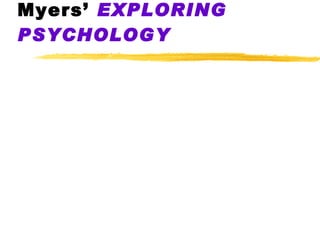
Learning Theories Explained
- 1. Myers’ EXPLORING PSYCHOLOGY
- 14. Pavlov’s Classic Experiment Before Conditioning During Conditioning After Conditioning UCS (food in mouth) Neutral stimulus (tone) No salivation UCR (salivation) Neutral stimulus (tone) UCS (food in mouth) UCR (salivation) CS (tone) CR (salivation)
- 16. Classical Conditioning UCS (passionate kiss) UCR (sexual arousal) CS (onion breath) CS (onion breath) CR (sexual arousal) UCS (passionate Kiss) UCR (sexual arousal)
- 18. Classical Conditioning Strength of CR Pause Acquisition (CS+UCS) Extinction (CS alone) Extinction (CS alone) Spontaneous recovery of CR
- 23. Nausea Conditioning in Cancer Patients UCS (drug) UCR (nausea) CS (waiting room) CS (waiting room) CR (nausea) UCS (drug) UCR (nausea)
- 42. Schedules of Reinforcement Variable Interval Number of responses 1000 750 500 250 0 10 20 30 40 50 60 70 Time (minutes) Fixed Ratio Variable Ratio Fixed Interval Steady responding Rapid responding near time for reinforcement 80
- 45. Punishment
- 54. Operant vs. Classical Conditioning
- 69. (Presence of reinforcement or punishment)
- 70. Reinforcement theory of motivation was proposed by BF Skinner and his associates. It states that individual’s behavior is a function of its consequences. (based on law of effect)
- 72. - Anything that increase the behavior - is a consequence of behavior that decreases the likelihood of repetition.
- 75. Television and Observational Learning
Editor's Notes
- Preview Question 4: Do cognitive processes and biological constraints affect classical conditioning?
- Preview Question 5: Why is Pavlov’s work important?
- Preview Question 7: What are the basic types of reinforcers?
- Preview Question 11: How might educators, business managers, and other individuals apply operant conditioning?
- Preview Question 12: What is observational learning?
